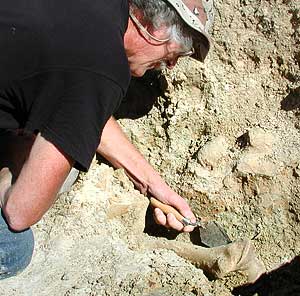The Florida Museum maintains five separate fossil vertebrate collections. The specimens derive mainly from the Cenozoic Era (last 65 million years), with more than 80% coming from about 1200 localities in Florida.
Other major contributing regions are islands in the Caribbean Basin, Central and South America, and intermontaine basins of Wyoming and Montana. Combined, the collections total about 1,500,000 specimens, of which more than 800,000 are catalogued and on a searchable online database. Holotypes number about 275 specimens.
 The primary and largest of our collections consists of specimens recovered by Florida Museum staff, graduate students, and volunteers and those donated to the museum. This collection is referred to as the UF collection.
The primary and largest of our collections consists of specimens recovered by Florida Museum staff, graduate students, and volunteers and those donated to the museum. This collection is referred to as the UF collection.
The other vertebrate fossil collections are the former collection of the Florida Geological Survey, portions of the Timberlane Research Organization collection, and the UF Department of Zoology Fossil Bird Collection (assembled by the late Professor Pierce Brodkorb). Each of these collections is maintained in a separately numbered catalog, under the acronyms UF/FGS, UF/TRO, and UF/PB, respectively.
The fifth collection (UF/IGM) is maintained for specimens collected in Colombia by joint expeditions of personnel from the Florida Museum of Natural History, the Instituto Nacional de Investigaciones Geologico-Mineras (Bogota, Colombia), and the Smithsonian Tropical Research Institute. Following their preparation, casting or scanning, study, and publication, the original fossils will be housed in Bogota and casts will be stored in Gainesville.
Vertebrate Paleontology Database